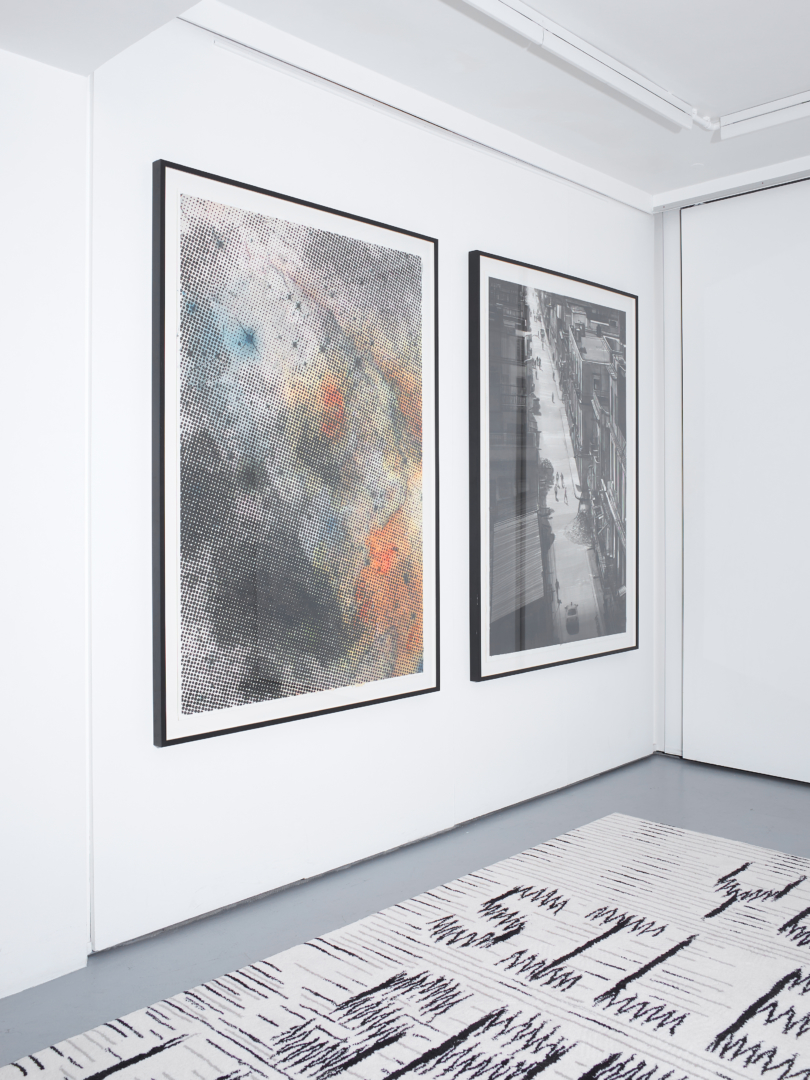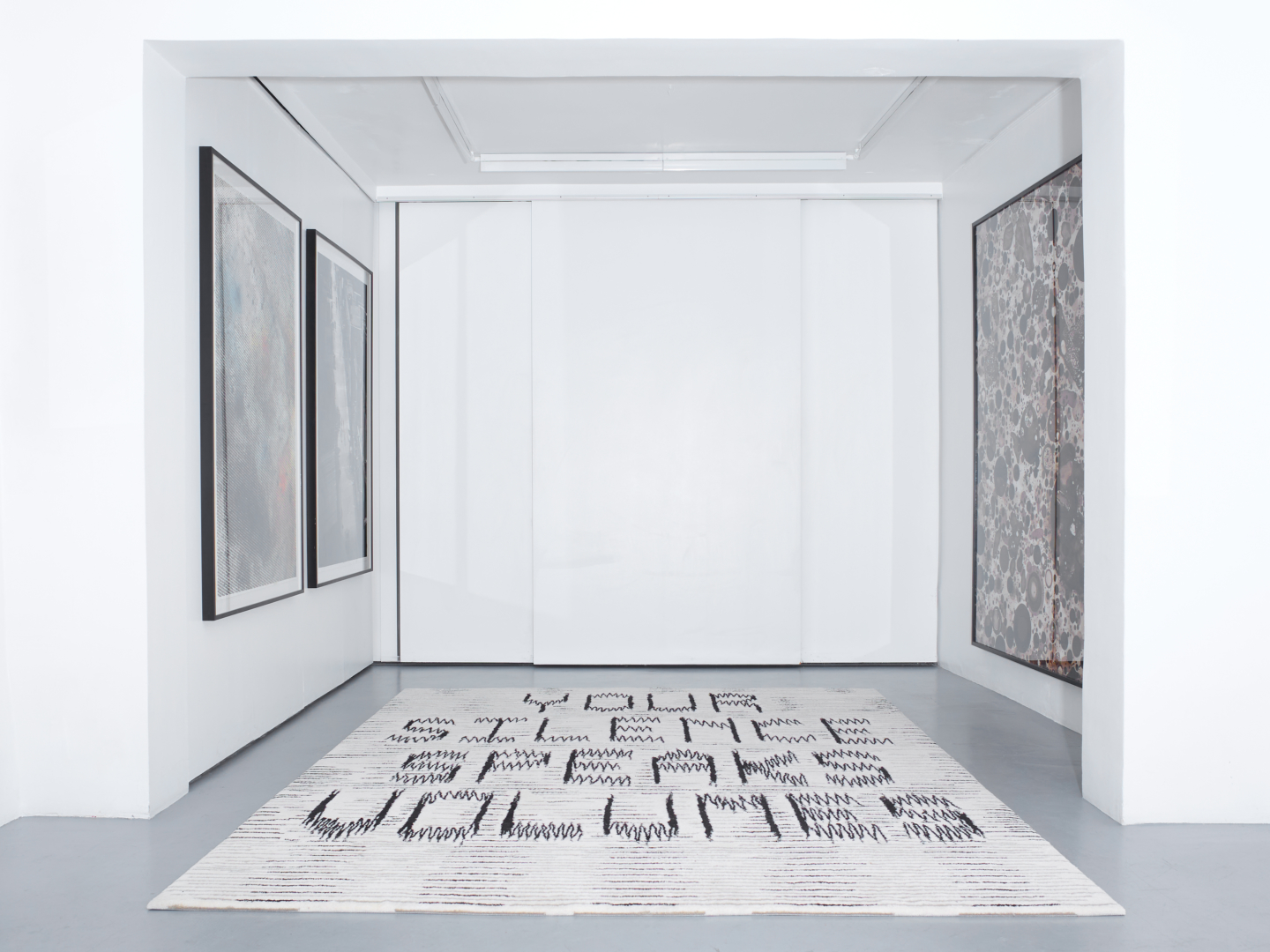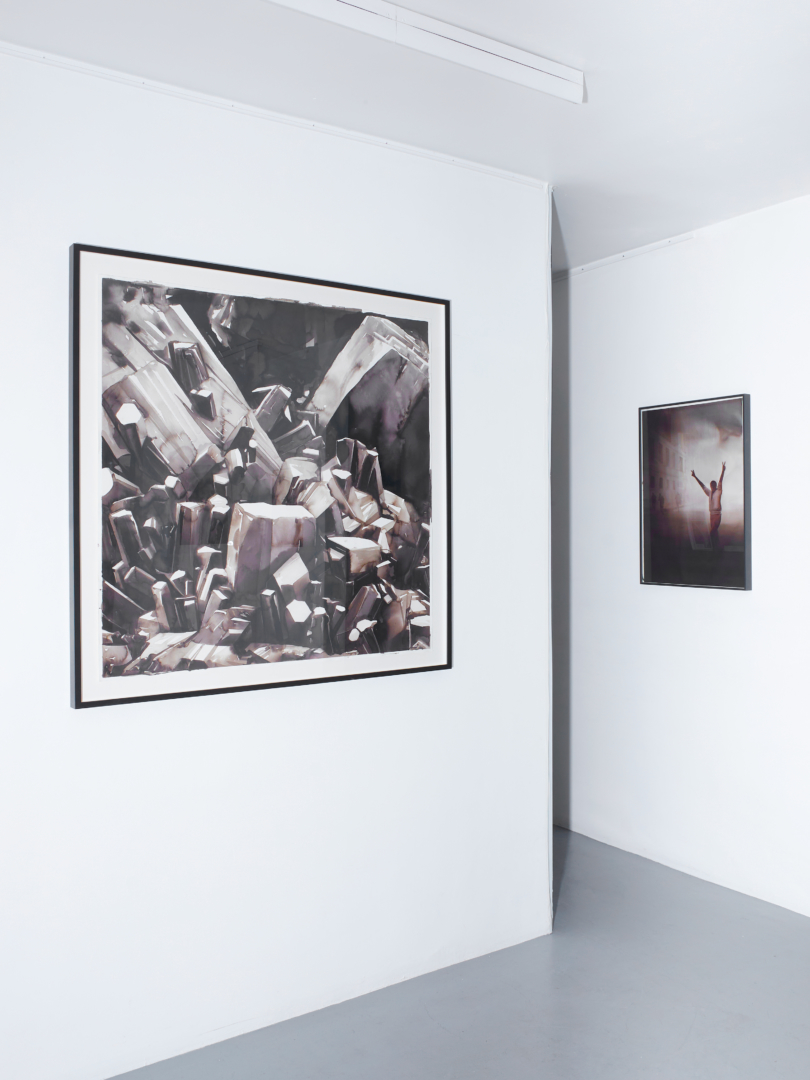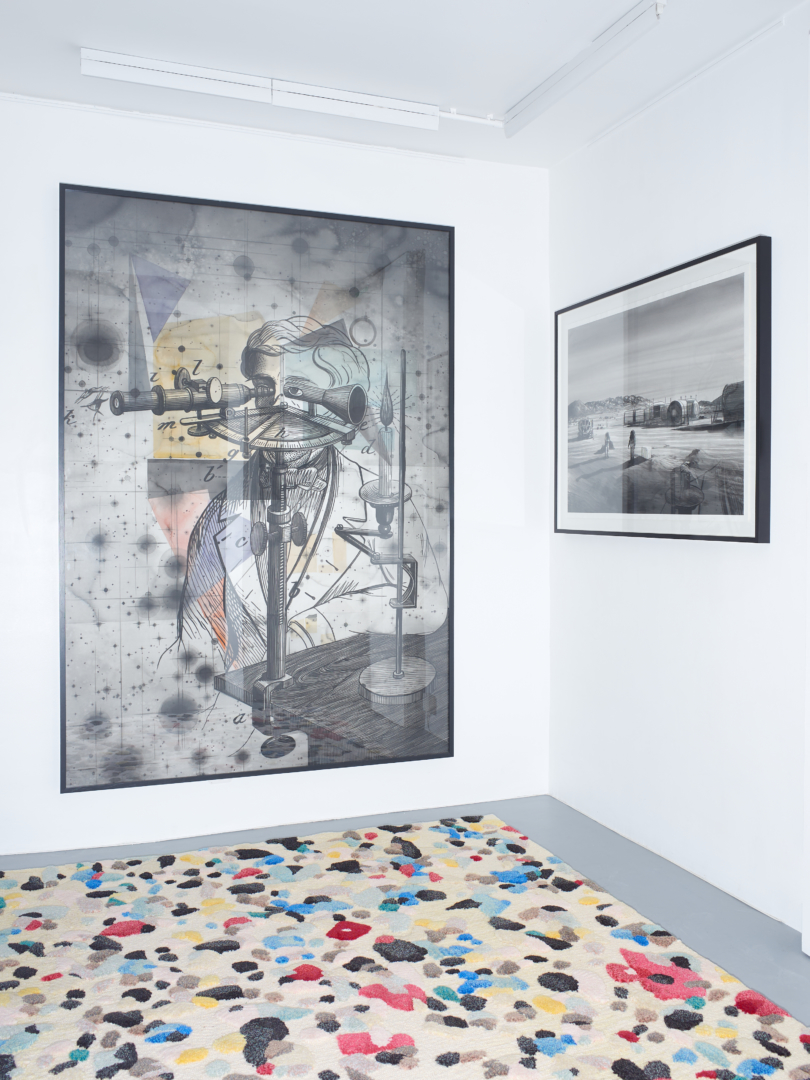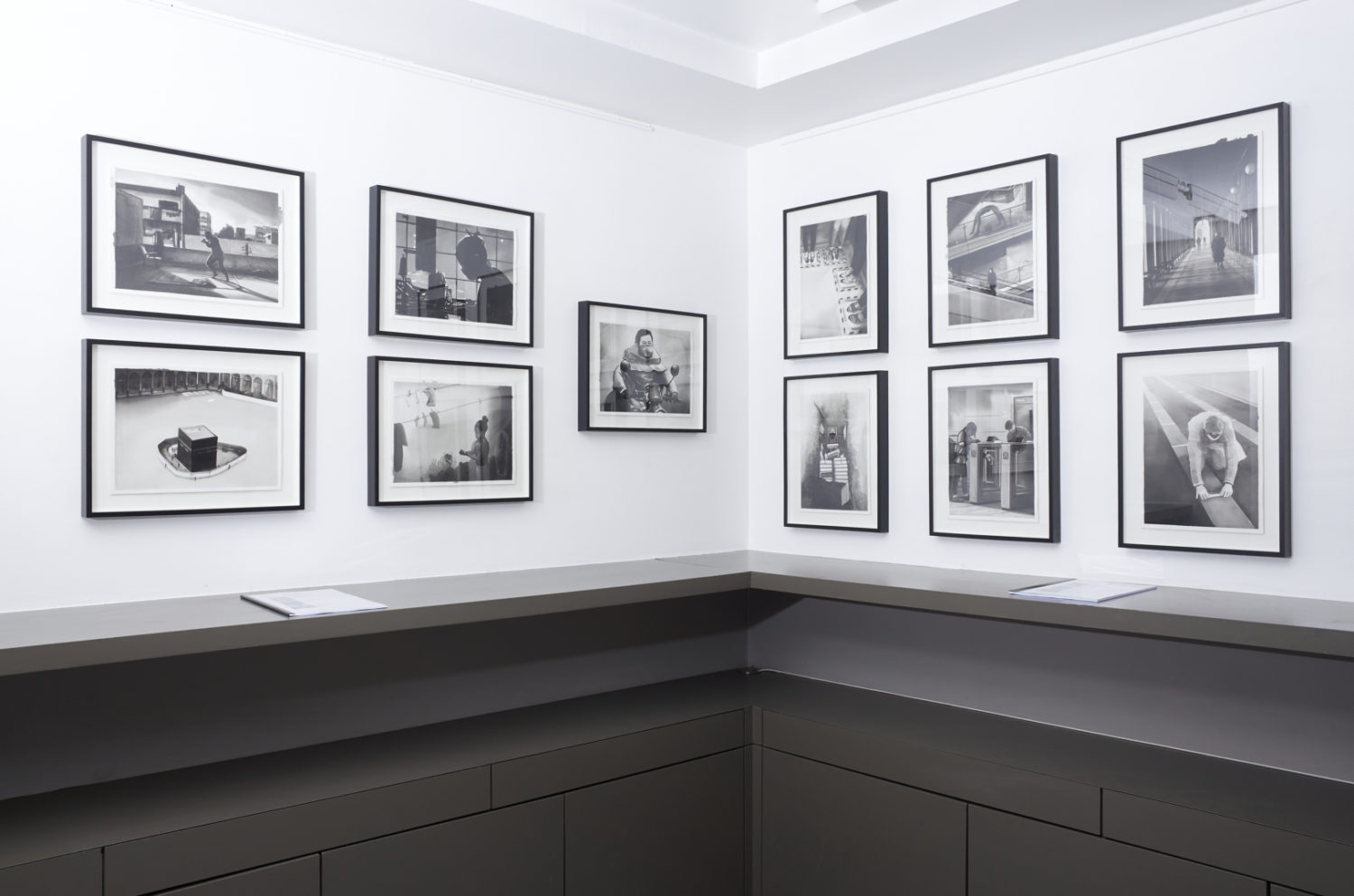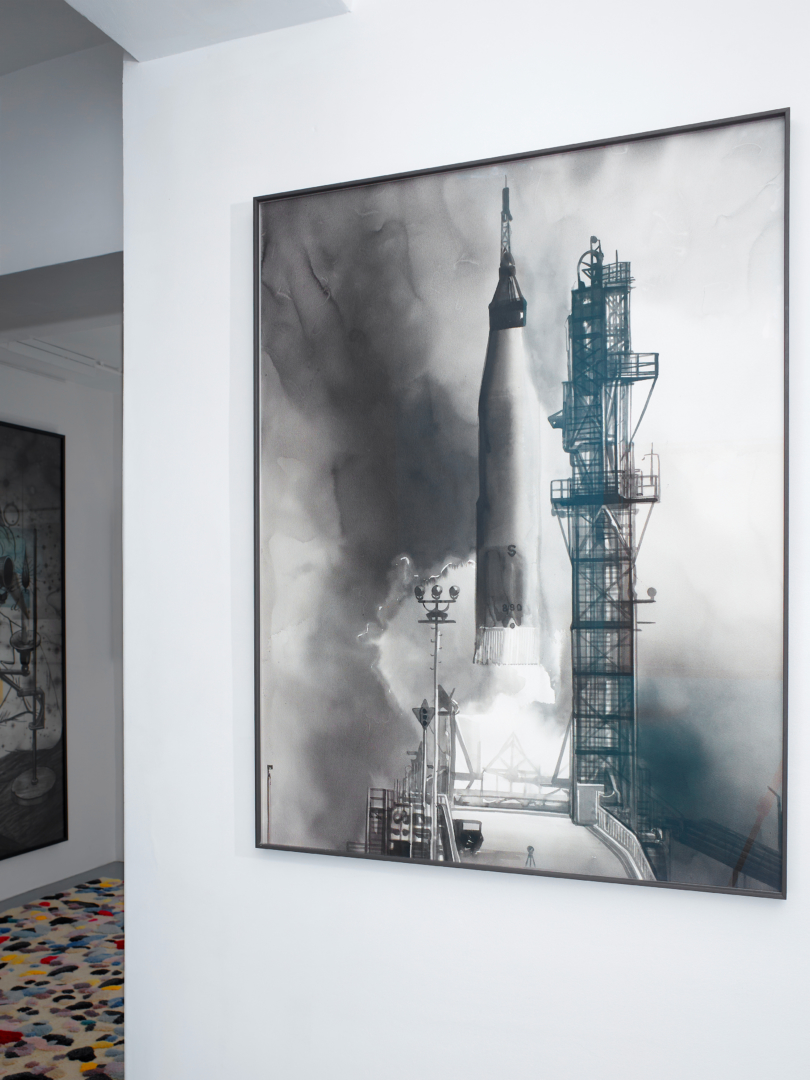PRISKA PASQUER PARIS
RADENKO MILAK – NAVIGATING THE UNKNOWN
Curated by WIEBKE HAHN
June 30, 2022
Opening from 6 pm-9 pm
July 1 – July 06, 2022 From 11 am-8 pm
Daily Reception from 6 pm to 8 pm
6 rue des Coutures Saint-Gervais, 75003 Paris
In collaboration with Photo Days Paris
Special thanks to Emmanuelle de l’Ecotais 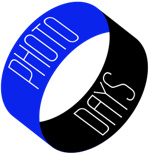
RADENKO MILAK
NAVIGATING THE UNKNOWN
For the second short term exhibition, Priska Pasquer Paris is delighted to host Bosnian artist Radenko Milak. His work is known for combining the photographic image with the painterly narrative. Milak rose to international acclaim in 2017 with “University of Disaster,” which he created for the Bosnia and Herzegovina pavilion at the Venice Biennale. The concept goes back to his project “365 – Image of Time.” Every day for a year, he painted a black-and-white watercolor of a historical event based on photos from the news. Viewed together, the series of pictures can be interpreted as an intense, extremely violent history of the 20th century, and forms the prelude to the Paris show. “Navigating the Unknown,” a kind of continuation, examines the current century and looks to the future. Various series of previous and brand new works enable us to experience things that aren’t yet visible, or rather comprehensible, prompting important debates about tomorrow’s world. How will it look once the climate catastrophe is over? How will humans, nature, and technology relate to each other ecologically? What new outlooks on life will arise as a result? In what direction will societal values have to develop?
Fact or fiction?
Although Radenko Milak almost always paints with watercolors, from a distance his works initially look like photographs. Only close up do the aqueous streaks characteristic of watercolors and the interplay between transparent and opaque areas of paint reveal his skillful artistry. As we draw closer, the notion of the depiction of reality still associated with the medium of photography begins to compete with the concept of a fictional narrative by the artist. In fact, Milak’s paintings are always based on photos. He finds them in magazines, newspapers, and on the internet, and then transfers them to the medium of painting. Like a chronicler of the present, he addresses major contemporary issues, identifying historical connections and documenting the many contradictions and global upheavals. He always focuses on individuals and the ramifications of their decisions. By moving highly topical news images to the medium of painting, he creates experimental access to our visual memory as well as a space where new connections and insights can arise.
A glimpse of the future – narratives between utopia and dystopia
The exhibition brings together various series of paintings in which Radenko Milak deals with themes that, epistemologically speaking, are still hidden from our gaze. This is probably why these topics – the future of human life on Earth, the infinite expanse of the universe and the possibility of colonizing it, and the future coexistence of humankind, nature, and technology – are also used in literary narratives to present different views of the future between dystopia and utopia.
Outer space – a cosmos entirely beyond the realm of natural perception – has been a projection surface for mythology and utopians since time immemorial. What was long mere fantasy is now being discussed by scientists as a possible vision of the future, even though the universe can only be experienced by humans with the aid of high-tech instruments. Take the colonization of Mars, for example – is that a realistic scenario or pure science fiction? The series entitled “Anthropocene” also reveals things that can only be seen by means of optical processes. What appears to be an abstract visual world depicted in bright, cheerful colors is actually microplastics on the beach, whose tiny particles can only be perceived using nanoscale microscopy. By contrast, the consequences of environmental pollution are plainly tangible, which is why there has long been talk of a new geological epoch, the Anthropocene.
A new series of works by Milak deals with the digitalization of society. The foundations of digital processes aren’t just invisible, but for many also completely abstract. The notion of a metaverse (a term coined by science fiction author Neal Stephenson in his novel Snow Crash) as a virtual reality existing in parallel and in connection with physical reality, is a literally fantastic image of the future between fact and fiction (much like the colonization of the universe) that Milak makes more understandable in his paintings. The particular quality of his work is rooted in his artistic practice, for the moment of deceleration stemming from the transfer to painting also continues in the perception and examination of each picture’s theme.
The aesthetic potential of images
By transferring the physical, digital process back into a hand-made medium, Milak blurs the boundary between objective and subjective reality. Art historian Peter Geimer rightly sees in this method a critical stance, for rather than simply copying a news image, the possibility or impossibility of reproducing it is called into question. The focus of attention is ultimately on the aesthetic potential of images and how they stimulate the imagination to approach the supposedly unknown.
Text: Wiebke Hahn
Radenko Milak (born in 1980 in Travnik, Bosnia and Herzegovina, lives in Banja Luka, Bosnia and Herzegovina) studied at University of Banja Luka Academy of Arts as well as Belgrade University of Art in Serbia. His first major solo exhibition in Germany was hosted in 2014 by Kunsthalle Darmstadt. In 2017, Milak developed the multidisciplinary project University of Disaster for his solo exhibition at the Bosnia and Herzegovina Pavilion at the 57th Venice Biennale. The centerpiece comprised four large-format, complex watercolors depicting various disasters caused by humans; they are now in the collection of Museum Folkwang in Essen. In 2019, works by Milak were included in the large show HYPER! A Journey into Art and Music at Deichtorhallen Hamburg. In 2020, Radenko Milak held a solo exhibition entitled Disaster of the Unseen (October 15 – November 29, 2020) at the Museum of Contemporary Art in Zagreb. A selection of his works was also included in the exhibition Deceptive Images – Playing with Painting and Photography at Marta Herford (October 30, 2020 – August 15, 2021).
About the gallery PRISKA PASQUER
Since its foundation in 2000, PRISKA PASQUER has focused on artists from Germany and abroad known for their groundbreaking approaches in the way they depict the radical changes taking place in our era. Starting with photography, its program has been steadily expanded to include intermedial positions in painting, sculpture, performance, installation, virtual and augmented reality, and audio and video works. Since the start of the pandemic, its analog exhibition program has been supplemented by digital exhibitions in its virtual gallery space, and PRISKA PASQUER now has a steadily growing archive of NFTs (non-fungible tokens) reflecting this current trend in digital images. In connection with Art Düsseldorf 2022, PRISKA PASQUER is presenting a selection of artists whose works address technical developments related to digital processes, examine the formation of identity in the digital age, take a stand in the debate about diversity and equality, and prompt discussions about the dramatically changing world.
RADENKO MILAK
NAVIGATING THE UNKNOWN
Priska Pasquer Paris freut sich im Rahmen der zweiten short term Ausstellung den bosnischen Künstler Radenko Milak zu präsentieren. Seine Arbeit vereint das fotografische Abbild mit der malerischen Erzählung. Internationale Bekanntheit erlangte Milak 2017 durch seinen künstlerischen Beitrag „University of Disaster“ für den Pavillon von Bosnien und Herzegowina der Biennale Venedig. Die Idee basiert auf seinem Projekt „365 – Image of Time“, für das er ein Jahr lang täglich auf der Basis von Fotos ein schwarz-weiß-Aquarell eines historischen Ereignisses gemalt hat. In der Zusammenschau liest sich die Bilderserie wie eine intensive und extrem gewaltsame Geschichte des 20. Jahrhunderts. Sie bildet den Auftakt der Pariser Schau. Als eine Art Fortsetzung durchleuchtet „Navigating the Unknown“ das aktuelle Jahrhundert und richtet den Blick in die Zukunft. Verschiedene Serien von älteren und ganz neuen Arbeiten machen das noch nicht Sichtbare oder besser: Begreifbare erfahrbar und stoßen damit wichtige Diskussionen über die Welt von Morgen an: Wie wird diese nach dem Ende der Klimakatastrophe aussehen? Wie werden sich Mensch, Natur und Technik ökologisch zueinander verhalten? Welche neuen Lebensperspektiven werden daraus resultieren? In welche Richtung müssen sich gesellschaftliche Werte entwickeln?
Fakt oder Fiktion?
Bis auf wenige Ausnahmen malt Radenko Milak mit Aquarellfarben, doch von weitem betrachtet suggerieren seine Arbeiten zunächst eine fotografische Oberfläche. Erst aus nächster Nähe angeschaut offenbart sich die virtuose, künstlerische Handschrift durch die für die Aquarelltechnik charakteristischen Wasserränder und das Zusammenspiel aus transparenten und deckenden Farbflächen. Mit jedem dem Bild näherkommenden Schritt beginnt die Vorstellung eines Abbildes des Realen, das noch immer mit dem Medium der Fotografie verbunden wird, mit der Idee von einer fiktionalen Erzählung des Künstlers zu konkurrieren. Tatsächlich bilden Fotografien stets die Grundlage der Darstellungen. Diese recherchiert Milak in Magazinen, Tageszeitungen und im Internet und überträgt sie anschließend in das Medium der Malerei. Wie ein Chronist der Gegenwart beschäftigt sich der Künstler so mit den großen Fragen unserer Zeit, schafft historische Verknüpfungen und dokumentiert die zahlreichen Widersprüche und globalen Umbrüche. Im Fokus steht dabei immer der Mensch und wie seine Entscheidungen nachwirken. Indem der Künstler die hochaktuellen Nachrichtenbilder in das Medium der Malerei überträgt, schafft er einen experimentellen Zugang zu unserem Bildgedächtnis und einen Möglichkeitsraum für neue Verknüpfungen und Erkenntnisse.
Ein Blick in die Zukunft: Erzählungen zwischen Utopie und Dystopie
Die Ausstellung vereint verschiedene Bildserien, in denen sich Radenko Milak mit Themen auseinandersetzt, die erkenntnistheoretisch noch im Verborgenen liegen. Wohl gerade deshalb spielen sie auch in literarischen Erzählungen eine große Rolle, wo sie zwischen Dystopie und Utopie unterschiedliche Zukunftsperspektiven ausmalen: Die Zukunft des Lebewesen Mensch auf der Erde, die unendliche Weite des Universums und die Möglichkeit seiner Besiedlung, das zukünftige Miteinander von Mensch, Natur und Technik.
Seit jeher ist der Weltraum – als ein Kosmos, der ganz und gar außerhalb der natürlichen Wahrnehmungsfähigkeit liegt – Projektionsfläche für Mythologie und Utopist*innen. Was lange bloße Fantasterei war, wird heute von Wissenschaftler*innen als mögliche Zukunftsvision diskutiert, obwohl das Universum nur mittels hoch-technologisierten Hilfsmitteln für die Menschheit überhaupt erfahrbar ist. Ist nun beispielsweise die Besiedlung des Mars ein realistisches Szenario oder pure Science-Fiction? Auch die „Anthropozän“-Serie offenbart Dinge, die nur Dank optischer Verfahren sichtbar werden. Was wie eine abstrakte Bildwelt in fröhlich-bunten Farben anmutet, ist tatsächlich das Mikroplastik am Strand, deren winzigen Teilchen nur mittels Nanomikroskope wahrgenommen werden können. Spürbar hingegen sind die Folgen der Umweltverschmutzung, weswegen längst von einem neuen geochronologischen Erdzeitalter, dem Anthropozän, gesprochen wird. Eine Serie von neuen Arbeiten Milaks setzt sich mit der Digitalisierung der Gesellschaft auseinander. Das Fundament der digitalen Prozesse ist nicht nur unsichtbar, sondern für viele vollkommen abstrakt. Die Vorstellung eines Metaverse (den Begriff prägte der Sci-Fi-Autor Neal Stephenson in seinem Roman „Snow Crash“) als eine virtuelle Realität, die parallel und in Verbindung zur physischen Realität existiert, ist ähnlich wie die Besiedlung des Universums wortwörtlich ein fantastisches Zukunftsbild zwischen Fakt und Fiktion, das Milak durch seine Werke begreifbarer macht. Hier liegt die besondere Qualität in seiner künstlerischen Praxis: Der dem malerischen Transfer geschuldete Moment der Entschleunigung setzt sich auch in der Wahrnehmung und Auseinandersetzung mit dem Bildthema fort.
Über das ästhetische Potenzial von Bildern
Indem Milak den physikalisch-digitalen Prozess zurück in ein hand-gemachtes Medium überführt, verschwimmt die Grenze zwischen objektiver Realität und subjektiver Wirklichkeit. Zu Recht macht der Kunsthistoriker Peter Geimer in dieser Methode des malerischen Transfers eine kritische Haltung aus. Denn das Nachrichtenbild wird nicht einfach nur kopiert, sondern vielmehr werden die Möglichkeit oder Unmöglichkeit einer solchen Abbildung hinterfragt. Im Fokus steht schlussendlich das ästhetische Potenzial von Bildern und wie sie die Vorstellungskraft anregen, sich dem vermeintlich Unbekannten zu nähern.
Text: Wiebke Hahn
Radenko Milak (*1980 in Travnik, Bosnien und Herzegowina, lebt in Banja Luka, Bosnien und Herzegowina) studierte an der Kunstakademie in Banja Luka und an der Kunsthochschule in Belgrad, Serbien. 2014 präsentierte die Kunsthalle Darmstadt seine erste große Einzelausstellung in Deutschland. 2017 entwickelte MILAK für seine Einzelausstellung im Pavillon von Bosnien und Herzegowina auf der 57. Biennale Venedig das multidisziplinäre Projekt „University of Disaster“. Im Zentrum standen vier großformatige, komplex komponierte Aquarelle zu verschiedenen, von Menschen herbeigeführten Desastern. Sie befinden sich heute in der Sammlung des Museum Folkwang, Essen. 2019 waren Milaks Werke in der großen Schau „HYPER! A JOURNEY INTO ART AND MUSIC“ in den Deichtorhallen Hamburg zu sehen. 2020 hatte Radenko Milak die Einzelausstellung „Desaster of the Unseen“ (15.10.2020 – 29. November 2020) im Museum of Contemporary Art in Zagreb, im selben Jahr zeigte das Marta Herford eine Auswahl seiner Werke in der Ausstellung „Trügerische Bilder – Ein Spiel mit Malerei und Fotografie“ (30.10.2020 – 15.8.2021).
Über die Galerie PRISKA PASQUER
Seit der Gründung im Jahr 2000 konzentriert sich PRISKA PASQUER auf nationale und internationale Künstler*innen, die sich in ihrer Praxis wegweisend mit den radikalen Veränderungen unseres Zeitalters auseinandersetzen. Von einem Fokus auf die Fotografie ausgehend, wurde das Programm kontinuierlich um intermediale Positionen aus den Bereichen Malerei, Skulptur, Performance, Installation, Virtual und Augmented Reality sowie Audio- und Videoarbeiten ergänzt. Seit dem Beginn der Pandemie erweitern auch digitale Ausstellungen im virtuellen Galerieraum das analoge Ausstellungsprogramm und ein stetig wachsendes NFT-Archiv (NonFungible Token) greift den aktuellen digitalen Bildtrend auf.




